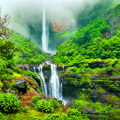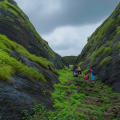Every once in a while, life calls for a journey that goes beyond sightseeing one that speaks to the soul. My recent adventure to Mangi Tungi, the sacred twin-peaked hill in Maharashtra, was just that. Nestled amidst the serene hills of Nashik, this ancient site isn’t just a pilgrimage spot; it’s a timeless realm where devotion, nature, and history blend into one unforgettable experience.
We started our journey from Ambarnath Station, bags full of essentials, and hearts full of excitement. What awaited us wasn’t just a trek, but a deeply spiritual expedition 3,500 steps of reflection, belief, and breathtaking beauty.
So lace up your trekking shoes and join me as I relive every moment of this magical climb to the world’s tallest Jain statue, hidden caves, and the whispers of legends etched in stone.
From Neminath Temple to Iconic Rishabhdev Statue
As we began climbing, the path revealed ancient Jain caves and temples, nestled at intervals between steep flights of stairs. Our first major stop was the Bhagwan Neminath Temple, a peaceful shrine perfect for a short prayer break.
Continuing upward, we finally arrived at the top, where a lift facility is available for senior citizens or those with difficulty climbing. But for us, the walk was part of the pilgrimage a test of endurance, faith, and awe.
At the summit stands the majestic Statue of Ahimsa, a 108-foot-tall monolithic idol of Bhagwan Rishabhdev, the first Tirthankara of Jainism. Consecrated in 2016, it holds the record as the world’s tallest Jain statue, a fact certified by the Guinness Book of World Records.
Sculpted from a single stone and placed on a 5-foot pedestal (total height: 113 ft), this statue is a magnificent representation of peace and non-violence (Ahimsa).
Standing before it, I felt humbled not just by its scale, but by the energy it radiates.
Mangi and Tungi
Post the statue, the stairs split into two paths one leading to Mangi Hill and the other to Tungi Hill. Each peak offers unique shrines, panoramic views, and centuries-old stone carvings.
Mangi Giri is home to seven ancient temples, each echoing the silence of devotion and centuries-old stories. Among its most sacred spots is Krishna Kund, a serene pond believed to have witnessed the final days of Lord Krishna. Not far from it lies the Balram Cave, enshrining idols of Balram and other revered saints. The Mahavir Cave and the well-known Cave No. 6 house finely carved idols of Lord Mahavir, Adinath, and Parshvanath, making it a spiritual haven for Jain followers. The walls here are adorned with beautiful carvings of Tirthankaras and ascetic saints, many of whom are believed to have attained moksha (salvation) from this sacred site.
Moving towards Tungi Giri, one discovers five more temples, each carrying its own legacy. The Lord Chandraprabh Cave stands out with its beautifully sculpted idol of Chandraprabh, the eighth Tirthankara. A highlight of Tungi is the presence of idols of Lord Ram, Hanuman, Sugriva, and several Jain monks, a unique confluence of Jain and epic-era traditions. The Ram Chandra Cave holds a rare ascetic idol of Kritantvakra, the army-chief of Lord Ram, depicted in a meditative pose. Scattered across these caves are rare sculptures in Padmasan (lotus position) and Kayotsarga (standing meditation) postures, giving visitors a sense of timeless spiritual energy that surrounds these majestic hills.
Final Thoughts
Mangi Tungi stands as a remarkable confluence of faith, history, and natural beauty nestled in the majestic Sahyadri ranges of Maharashtra. From its towering 108-feet Statue of Ahimsa to the sacred caves and intricately carved temples spread across Mangi and Tungi hills, the site offers a profound spiritual and cultural experience. Whether you’re a pilgrim, a history enthusiast, or a nature lover, Mangi Tungi invites you to step into an atmosphere of peace, devotion, and timeless heritage shaped by centuries of Jain tradition and the serene strength of the Sahyadris.




